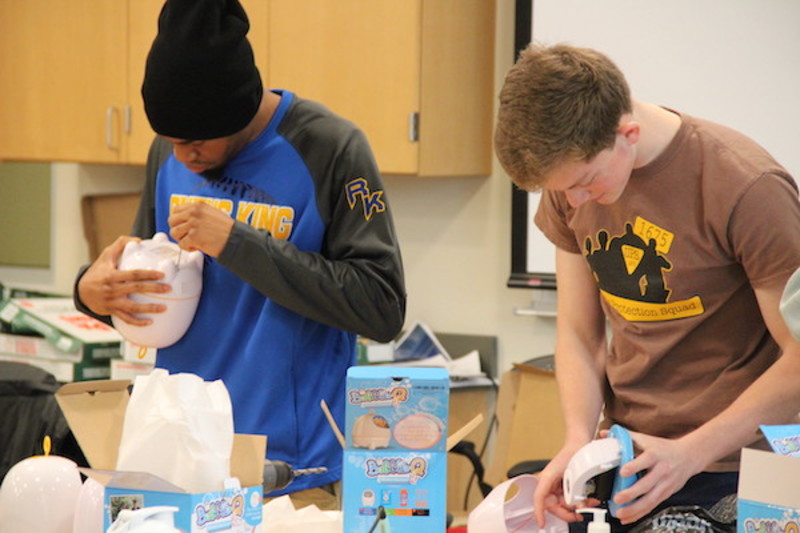As part of the Inclusive Play Project at in Milwaukee, Wisconsin, three local FIRST Robotics high school teams and engineering students from Marquette University’s adapted electronic toys to make them easier to use — adding larger buttons, relocating buttons, and adding tethers. The students spent two days disassembling the toys, drilling holes, installing grommets, rewiring, and soldering.
Making Toys More Accessible
“These adapted toys teach important lessons at the early stages of development because they’re learning cause and effect — push a button and something happens,” says Vladimir Bjelic, a speech-language pathologist at Penfield who initiated the effort to get more accessible toys into the hands of children with cognitive and fine motor delays. “We see the kids' reactions to these toys are completely different because they're the ones doing it instead of me activating the toy for them. One boy who couldn’t crawl or sit up saw the bubble machine and rolled over to push the button on it. It’s very empowering.”


A child uses a newly adapted bubble machine.
How to Keep Costs Low
Bjelic was originally going to purchase adapted toys, but when he discovered that they cost six times more than the standard versions, he started reaching out to friends for help. He was connected with , research engineer at the . Erickson had been heading up , a program that provides modified ride-on cars to children with limited mobility.
FIRST Robotics Teams to the Rescue
As a high school student, Molly was on a FIRST Robotics team, earned a FIRST-sponsored college scholarship to , and eventually was hired by the school. For the last few years, she’s been a coach and mentor for FIRST Robotics – Ultimate Protection Squad — comprised of students from four Milwaukee public schools.
Erickson was immediately interested in helping Penfield with its Inclusive Play Project but knew she couldn’t do all the work alone. She brought in her FIRST Robotics team and asked other area FIRST teams to help. Over two days, 30 high school students from FIRST Robotics Team 1675, , and other teams worked with the college students and used adaptation kits funded by donors to transform the toys.
Erickson knew the FIRST teams could handle the challenge because of the skills they already had.
“They were trained in tool safety, like using drills and other hand tools, as well as electrical skills,” Erickson says. “They already knew how to strip wires, so we didn’t have to teach them that. The work they’d done in FIRST Robotics was incredible, and this program helped them see the bigger picture of the skills they had acquired.”
Making Play Come First
The students are already excited to participate in the adapted toys program next year, with the goal of making even more toys for Penfield. The Center just opened up a toy loan program to local therapists, teachers, and parents, so they’ll need a lot of toys. With the skills learned in FIRST Robotics, these young people are making sure that play comes first for all kids.
Find Inspiration at Student Summit at IMTS 2024 Many FIRST teams visit the — one of the world’s largest displays featuring hands-on opportunities for young people to explore careers in advanced manufacturing by working with 3D printers, high-tech metal cutting machines, programming and design software, robotics, automation, and more. Check it out at .









